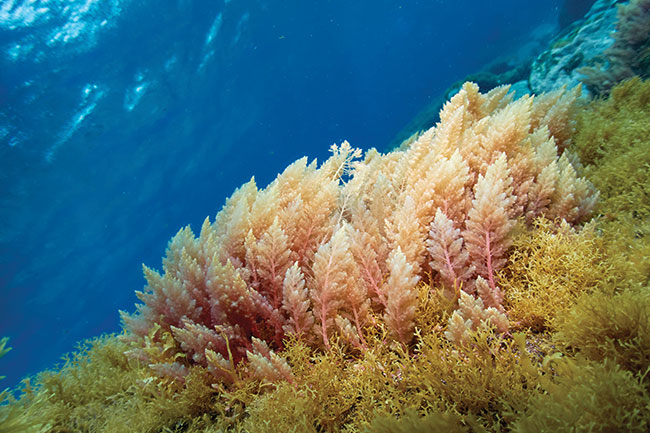
Features
Innovation
Deep in the (sea)weeds
By Robyn Roste
Could seaweed in dairy cattle feed be a game-changer for GHG emissions?
 One consideration researchers are pointing to for the future is the potential impact if production of the seaweed reaches a global scale.
Photo © Luis Masuhr, Pidjin / Adobe Stock
One consideration researchers are pointing to for the future is the potential impact if production of the seaweed reaches a global scale.
Photo © Luis Masuhr, Pidjin / Adobe Stock In 2022, headlines around the world declared that the methane emitted into the atmosphere from cow burps had been measured from space by Montreal-based greenhouse gas (GHG) emissions monitoring company GHGSat Inc.
Globally, there are approximately 9.4 million heads of dairy cattle and the average dairy cow belches approximately 350 pounds of methane each year. According to GHGSat Inc., this would provide enough emissions to power more than 15,000 homes.
An attention-grabbing concept, to be sure. GHG emissions from animal agriculture are of particular interest to many countries, since about 15 per cent of the world’s total GHG emissions come from livestock production.
And although “cow burps” grabbed a lot of mainstream attention from that headline, researchers in the agriculture community have understood the link between ruminant digestion and climate change for decades, and have been working to discover methods to either harness or reduce methane emissions.
Methane (CH4) is odourless and colourless and, up until 2022, escaped unmeasured into the atmosphere. It’s a natural byproduct of a ruminant’s digestive process, and is released either through belching or manure.
Harnessing methane emissions has typically been achieved through measures such as covering manure pools with straw, transforming the gas into renewable power through manure storage systems or altering the acidity of the manure, which deactivates the microorganisms that produce methane.
One of the most promising solutions for reducing methane emissions is through food additives.
In an article on Canada.ca on reducing methane emissions from livestock, Karen Beauchemin from Agriculture and Agri-Food Canada said, “since approximately 40 per cent of agricultural emissions in Canada come directly from methane, with 90 per cent from cattle and sheep methane emissions as a result of feed digestion, agricultural methane emissions can be reduced through livestock feeding and management systems.” For example, adding sunflower oil to a typical North American cow diet of corn, distillers’ grain, silage, vitamins and minerals can reduce emissions by about 15 per cent.
Another additive, 3-nitrooxypropanol (3-NOP) has been shown to reduce methane emissions in cattle by an average of 30 per cent. These findings were published in the research article titled, An inhibitor persistently decreased enteric methane emission from dairy cows with no negative effect on milk production by Alexander Hristov, Joonpyo Oh, Fabio Giallongo and Stephane Duval. Although not yet approved in Canada or the United States, Bovaer (a feed additive based on the 3-NOP compound) is approved for use on dairy cows in Brazil, Chile and the EU.
Most recently, a food additive derived from tropical red seaweed has captured researchers’ interest for its ability to act as a methane inhibitor. Called Asparagopsis taxiformis, this species of red algae has been shown to reduce methane emissions when ruminants are fed a diet containing a small percentage of the seaweed additive.
“It does work,” says Alexander Hristov, distinguished professor of dairy nutrition at Penn State University. “Our research shows Asparagopsis reduces methane by between 25 and 30 per cent and doesn’t seem to have side effects [on] feed intake or milk production. We did see an improvement in milk fat per cent, which is good news.”
For almost 20 years, Hristov has researched ways to reduce the amount of methane created by dairy cows. His current work includes feeding cows different amounts of additives and monitoring their methane production in order to determine both the optimal amount and long-term impacts.
In 2014, Australian researchers discovered the methane-reducing properties contained in Asparagopsis taxiformis and in subsequent years, interest in its potential for inhibiting methane production in cattle has grown. The seaweed species produces bromoform, a bioactive compound, which prevents methane formation through inhibiting the enzyme methyl coenzyme M reductase (MCR).
Initial results are overwhelmingly positive, but there is still much to learn about its long-term effectiveness, safety, feasibility and sustainability, should the demand for the additive become a mainstream solution to mitigate climate change on a global scale.
Recently, The Trough reported online that Hristov received a $2 million grant from the USDA’s Natural Resource Conservation Service (NRCS). This grant allows him to conduct a three-year study to determine whether the long-term impact of using 3-NOP or Asparagopsis taxiformis additives in lactating dairy cows feed will continue reducing methane emissions.
“The only concern we have with it are the long-term effects,” says Hristov. “That’s why we have this project with the NRCS, it’s designed exactly to look at long-term effects.” He adds that they’re also looking at how the ecosystem will adapt to increasing production of Asparagopsis taxiformis over time, since the current supply would not be adequate if it becomes a worldwide additive in ruminant feed.
“It’s approved for use in Europe and in some Latin American countries. In the U.S. it’s still waiting for approval from the FDA before it can be used. I don’t think there will be any issues, it’s just a matter of time,” he says.
In nature, Asparagopsis taxiformis is found in coastal areas in temperate and subtropical waters. It is cultivated commercially through aquaculture, which ensures it is grown and harvested sustainably in a controlled aquatic environment.
Increasing production could present a number of environmental challenges, which are yet undetermined. Creating the specific conditions Asparagopsis taxiformis requires to cultivate it on a large scale while maintaining quality would require infrastructure and systems, which don’t yet exist, in addition to increased water and land use, costs and energy consumption.
“We can see there are quite a few questions about the practicality and long-term effects. I think there are at least several outfits that claim they can cultivate Asparagopsis – that’s a major factor, it cannot be harvested wild. It has to be cultivated in agricultural conditions,” says Hristov.
Other considerations include the ecological impact on the marine environment and native species as well as developing nutrient runoff best management practices. Right now, companies in Australia and Hawaii are developing small-scale cultivation operations in the hopes it can grow and scale sustainably as the additive is approved in additional countries. Another concern researchers have is the amount of bromoform that is created during the cultivation of Asparagopsis taxiformis. Although it acts as a methane-inhibitor, it also contributes to ozone depletion once released into the atmosphere. Researchers are working to assess the potential impact if production of the seaweed reaches a global scale. “This may be an issue in the future,” says Hristov. “We’re attacking one environmental problem and there may be another one down the road.”
In addition to studying 3-NOP and Asparagopsis taxiformis additives, Hristov is running other projects to develop new methane inhibitors including other seaweed species, which do not produce bromoform. The initial results are positive.
“We’re finishing one trial now with a brown seaweed that seems promising.” Hristov adds that although they’re not in the initial stages of studying the methane-reducing potential of seaweed, there’s still a lot of work to be done in order to determine if the effect will continue to be the same strength over time.
Print this page